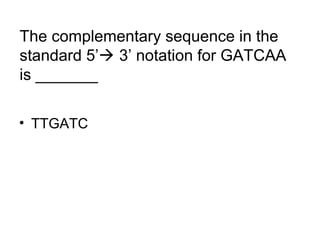
biochemistry questions with answers
- 1. The complementary sequence in the standard 5’ 3’ notation for GATCAA is _______ • TTGATC
- 2. List at least 3 non-covalent interactions in the biomolecules • van der Waals • Hydrogen bonds • Ionic bonds • Hydrophobic interactions
- 3. Explain the hydrophobic interactions • Hydrophobic interactions minimize interactions of non-polar components with aqueous solvent.
- 4. How are proteins separated by electrophoresis? • The separation of proteins is done by charge. pH is kept higher then the isoelectric pH (pI). So, the proteins will have negative charge and so the proteins will move towards the positive electrode.
- 5. Explain the definition of domain of proteins. • FFuunnddaammeennttaall ffuunnccttiioonnaall && tthhrreeee ddiimmeennssiioonnaall ssttrruuccttuurraall uunniittss ooff pprrootteeiinnss..
- 6. What is the function of chaperones in protein folding? List at least one role. • AAssssiisstt ffoollddiinngg • PPrrootteecctt aggregation • SSoommee ttiimmeess kkeeeepp pprrootteeiinn uunnffoollddeedd uunnttiill ssyynntthheessiiss iiss ccoommpplleettee..
- 7. Explain the difference between reversible denaturation and irreversible denaturation of proteins. • Some proteins can refold upon removal of denaturant. Other can’t refold upon the removal of denaturant.
- 8. Molecules contain both a positive and a negative charged functional group is called _____ • zwitterion
- 9. Hemoglobin is an allosteric protein that can exist in two states: R (relaxed) and T (taut). ____ state binds oxygen tighter. • R (relaxed)
- 10. The change in oxygen affinity with pH is known as the Bohr effect. Hemoglobin oxygen affinity is ____ (increased/decreased) as the acidity increases. • Reduced or decreased
- 11. Proteins that recognize and bind to a particular antigen with very high specificity belong to a group of serum proteins called ______. • Immunoglobulins or antibodies
- 12. What is the shape of the oxygen hemoglobin dissociation curve? How does the shape of the curve relate to the cooperative binding of O2? • Sigmoid or sigmoidal curve • The small change of oxygen partial pressure results in a greater change of the hemoglobin binding affinity to oxygen.
- 13. How does the shape of oxygen–hemoglobin dissociation curve influence loading of oxygen at the lung and unloading of oxygen at the tissue level? • There are a high oxygen partial pressure in the lung and a low oxygen partial pressure in the other tissues. At high oxygen pressure, the hemoglobin tends to be saturated with oxygen while, at low oxygen pressure hemoglobin tends to unload all the oxygen molecules.
- 14. List at least 3 factors that influence the binding of hemoglobin to oxygen. • carbon dioxide or CO2 • pH or acidity • Oxidative state of Fe in the heme group • 2,3-DPG or 2,3-BPG • Carbon monoxide or CO
- 15. _____ are long polymers of nucleotides. • Nucleic acids
- 16. The maximal UV absorbance of nucleic acids and proteins are at the wavelength of ___ nm and ___ nm, respectively. • 260, 280
- 17. The sugar groups in the nucleic acids are ___ (D/L) ribose while the residues in the protein are ___ (D/L) amino acids. • D, L
- 18. Polymer of nucleotides linked in a direction from ribose carbon ___ (3’/5’) to carbon ___ (3’/5’) by ______bonds. • 5’, 3’, phosphodiester
- 19. List at least 3 types of RNA molecules in the biological system. • ribosomal RNA or rRNA • messenger RNA or mRNA • transfer RNA or tRNA • microRNA or miRNA • small RNA or siRNA • long non-coding RNA • short non-coding RNA
- 20. Besides hydrophobic interactions, hydrogen bonding, and electrostatic interactions, nucleic acids have one more type of noncovalent interaction that is called ____. • Stacking interactions or base stacking (interactions between stacked bases)
- 21. What is DNA melting temperature? • the temperature at which a DNA double helix dissociates into single strands
- 22. What is the purpose of using the polymerase chain reaction (PCR) in diagnosis or research? • to rapidly amplify sequences of DNA
- 23. In the nucleosome, DNA wrapped around an octamer protein complex that are called ____. • histone
- 24. DNA binding proteins bind DNA in two ways: sequence-specific binding and non-sequence specific binding. Please list two example of non-sequence specific binding proteins. • Single-stranded nucleic acid binding proteins (SSB) • Exonucleases, RNase, or DNase • RNA polymerases or DNA polymerases • Topoisomerases
- 25. Define the enzyme active site. • The active site of an enzyme represents as the small region at which the substrate (s) binds and participates in the catalysis
- 26. Feedback Inhibition is a type of allosteric regulation for enzyme. When does feedback inhibition occur? • This occurs when an end-product of a pathway accumulates as the metabolic demand for it declines.
